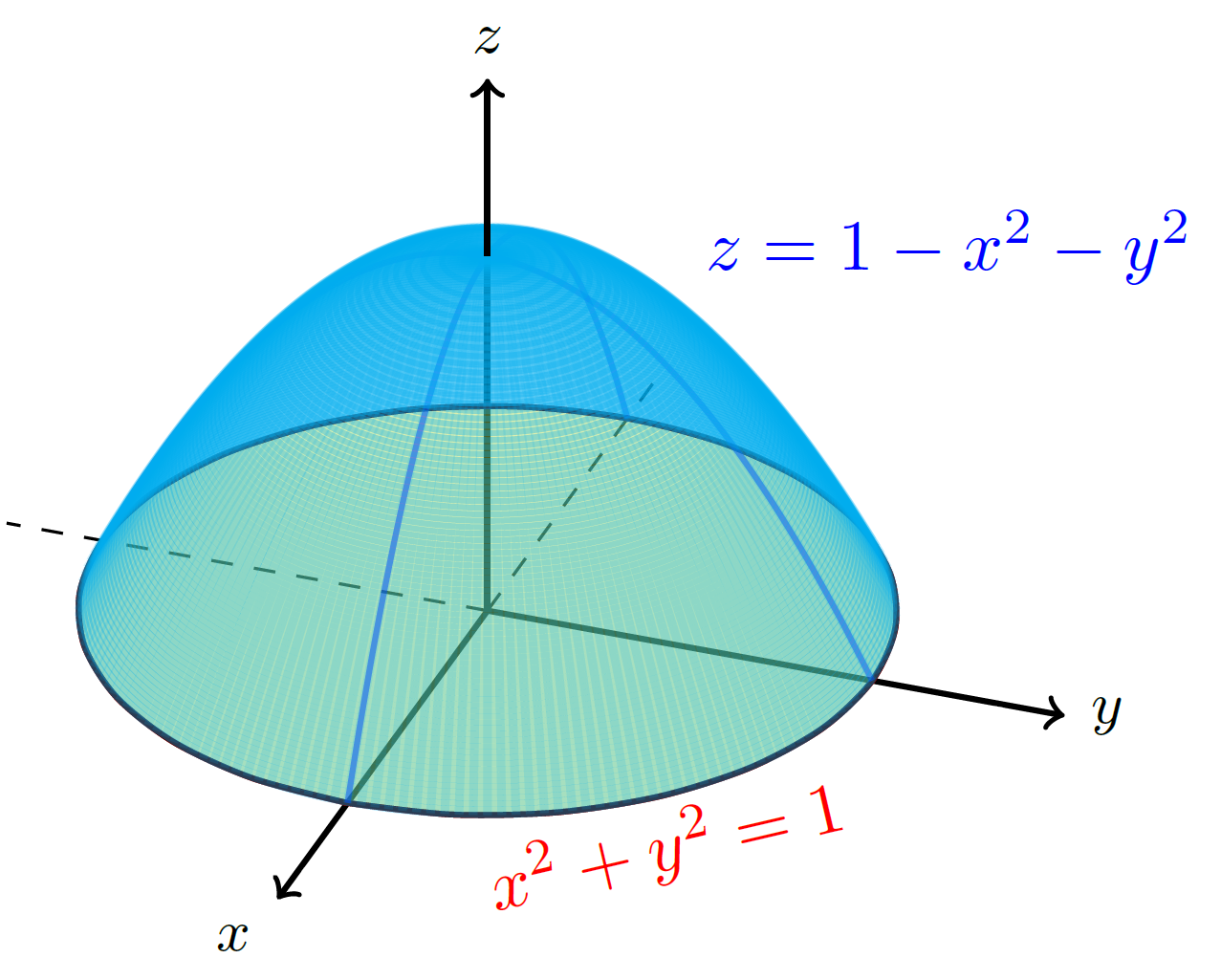Edit and compile if you like:
\documentclass{article}
%
% File name: concave-down-paraboloid.tex
% Description:
% The graph of the surface
% z = 1 - x^{2} - y^{2}
% for z >= 0 is generated. Also, the region x^2 + y^2 \leq 1
% is shown.
%
% Date of creation: April, 23rd, 2022.
% Date of last modification: April, 23rd, 2022.
% Author: Efraín Soto Apolinar.
% https://www.aprendematematicas.org.mx/author/efrain-soto-apolinar/instructing-courses/
% Terms of use:
% According to TikZ.net
% https://creativecommons.org/licenses/by-nc-sa/4.0/
%
\usepackage{tikz}
\usetikzlibrary{patterns}
\usepackage{tikz-3dplot}
\usepackage[active,tightpage]{preview}
\PreviewEnvironment{tikzpicture}
\setlength\PreviewBorder{1pt}
%
\begin{document}
%
\tdplotsetmaincoords{60}{110}
\begin{tikzpicture}[tdplot_main_coords,scale=2.0]
\pgfmathsetmacro{\tini}{0.5*pi}
\pgfmathsetmacro{\tfin}{1.85*pi}
\pgfmathsetmacro{\tend}{2.5*pi}
% Node indicating the equation of the circumference
\draw[white] (1.35,0,0) -- (0,1.35,0) node [red,below,midway,sloped] {$x^2 + y^2 = 1$};
%%% Coordinate axis
\draw[thick,->] (0,0,0) -- (1.5,0,0) node [below left] {\footnotesize$x$};
\draw[dashed] (0,0,0) -- (-1.25,0,0);
\draw[thick,->] (0,0,0) -- (0,1.5,0) node [right] {\footnotesize$y$};
\draw[dashed] (0,0,0) -- (0,-1.25,0);
\draw[thick] (0,0,0) -- (0,0,1.0);
% The region of integration
\fill[yellow,opacity=0.35] plot[domain=0:6.2832,smooth,variable=\t] ({cos(\t r)},{sin(\t r)},{0.0});
\draw[red,thick] plot[domain=0:6.2832,smooth,variable=\t] ({cos(\t r)},{sin(\t r)},{0.0});
% Circunference bounding the surface (for z = 0)
\draw[black,thick,opacity=0.75] plot[domain=0:6.2832,smooth,variable=\t] ({cos(\t r)},{sin(\t r)},{0.0});
% The curves slicing the surface
\draw[blue,thick,opacity=0.5] plot[domain=-1:1,smooth,variable=\t] ({\t},0,{1.0 - \t*\t});
\draw[blue,thick,opacity=0.5] plot[domain=-1:1,smooth,variable=\t] (0,{\t},{1.0 - \t*\t});
% Rotating a parabola about the z axis
\foreach \angulo in {0,2,...,358}{
\draw[cyan,very thick,rotate around z=\angulo,opacity=0.15] plot[domain=0:1,smooth,variable=\t] ({0},{\t},{1.0 - \t*\t});
}
% The paraboloid (for z = constant)
\foreach \altura in {0.0125,0.025,...,1.0}{
\pgfmathparse{sqrt(\altura)}
\pgfmathsetmacro{\radio}{\pgfmathresult}
\draw[cyan,thick,opacity=0.35] plot[domain=\tini:\tfin,smooth,variable=\t] ({\radio*cos(\t r)},{\radio*sin(\t r)},{1.0 - \altura});
}
% First part of the z axis
\draw[thick,->] (0,0,1.0) -- (0,0,1.5) node [above] {\footnotesize$z$};
\foreach \altura in {0.0125,0.025,...,1.0}{
\pgfmathparse{sqrt(\altura)}
\pgfmathsetmacro{\radio}{\pgfmathresult}
\draw[cyan,thick,opacity=0.35] plot[domain=\tfin:\tend,smooth,variable=\t] ({\radio*cos(\t r)},{\radio*sin(\t r)},{1.0 - \altura});
}
%
\node[blue,right] at (0,0.5,1.125) {$z = 1 - x^2 - y^2$};
\end{tikzpicture}
\end{document}
Click to download: concave-down-paraboloid.tex • concave-down-paraboloid.pdf
Open in Overleaf: concave-down-paraboloid.tex
See more on the author page of Efraín Soto Apolinar.


